Automatic Control of Irrigation and Increased Fertilization Frequency to Improve Lemon Production Under Dry Conditions
Abstract
1. Introduction
2. Materials and Methods
2.1. Location and Weather Conditions at the Test Site
2.2. Aspects of the Soil’s Physical and Chemical Makeup and Irrigation Water
2.3. Irrigation Requirements for Lemon
2.4. Experimental Design
2.5. Fertilizer Addition
2.6. Evaluation Parameters
2.6.1. Lemon Tree Roots Under Water Stress
2.6.2. Water Application Efficiency
2.6.3. Tree Canopy Volume
2.6.4. Lemon Yield and % Difference in Yield
2.6.5. Water Productivity of Lemon
2.6.6. Irrigation Water Savings
2.6.7. Quality Traits of Lemon
2.7. Statistical Analysis
3. Results and Discussion
3.1. Water Stress of Lemon Tree Roots
3.2. Application Efficiency of Irrigation Water
3.3. NPK Concentration in Soil
3.4. Tree Canopy Volume
3.5. Lemon Yield and % Difference in Yield
3.6. Lemon Water Productivity and Irrigation Water Saving
3.7. Lemon Fruit Quality
4. Conclusions
Author Contributions
Funding
Data Availability Statement
Acknowledgments
Conflicts of Interest
References
- Abdelraouf, R.E.; El-Shawadfy, M.A.; Ghoname, A.A.; Ragab, R. Improving Crop Production and Water Productivity Using a New Field Drip Irrigation Design. Plant Arch. 2020, 20, 3553–3564. [Google Scholar]
- Abdelraouf, R.E.; Okasha, E.M.; Tarabye, H.H.H. Modified Design for Drip Irrigation System to Improve the Productivity of Irrigation Water and Fertilizers Distribution. Int. J. Chemtech Res. 2016, 9, 40–52. [Google Scholar]
- Abdelraouf, R.E. Reuse of Fish Farm Drainage Water in Irrigation. In Unconventional Water Resources and Agriculture in Egypt; Springer: Cham, Switzerland, 2017; pp. 393–410. [Google Scholar]
- Abdelraouf, R.E.; Azab, A.; Tarabye, H.H.H.; Refaie, K.M. Effect of Pulse Drip Irrigation and Organic Mulching by Rice Straw on Yield, Water Productivity and Quality of Orange under Sandy Soils Conditions. Plant Arch. 2019, 19, 2613–2621. [Google Scholar]
- Eid, A.R.; Fathy, M.; El-Sayed, A.; Hafez, M.; El Shirbeny, M.A.; Reda, A.M.; Mady, A.Y. Validation of SALTMAD Model for Simulating Soil Moisture and Faba Bean Productivity under Deficit Irrigation and Integrated Fertilization in the Semi-Arid Regions. Soil Environ. 2023, 42, 111–129. [Google Scholar] [CrossRef]
- Dewedar, O.M.; El-Shafie, A.F.; Marwa, M.A.; Abdelraouf, R.E. Improvement of Irrigation Water Management Using Simulation Models And Artificial Intelligence Under Dry Environment Conditions in Egypt: A Review. Egypt. J. Chem. 2023, 66, 93–106. [Google Scholar]
- Eid, A.R.; Negm, A. Improving Agricultural Crop Yield and Water Productivity via Sustainable and Engineering Techniques. In Conventional Water Resources and Agriculture in Egypt; Springer: Berlin/Heidelberg, Germany, 2019; pp. 561–591. [Google Scholar]
- Geerts, S.; Raes, D. Deficit Irrigation as an On-Farm Strategy to Maximize Crop Water Productivity in Dry Areas. Agric. Water Manag. 2009, 96, 1275–1284. [Google Scholar] [CrossRef]
- Abdelbaset, M.M.; Dewedar, O.; Ramadan, A.; El-Shafie, A.F. Precision Irrigation Management Using Automatic Scheduling Techniques under Environmental Drought Stress Conditions in Egypt: A Review. Egypt. J. Chem. 2023, 66, 403–413. [Google Scholar]
- Abdelraouf, R.E.; El-Shawadfy, M.A.; Dewedar, O.M.; Hozayn, M. Improving Yield and Water Productivity of Canola under Sprinkler Irrigation and High Frequency of N-Fertigation. Asian J. Plant Sci. 2021, 20, 143–156. [Google Scholar] [CrossRef]
- Liu, Z.; Xu, Q. Wetting Patterns Estimation in Cultivation Substrates under Drip Irrigation. Desalination Water Treat. 2018, 112, 319–324. [Google Scholar] [CrossRef]
- Karimi, B.; Mohammadi, P.; Sanikhani, H.; Salih, S.Q.; Yaseen, Z.M. Modeling Wetted Areas of Moisture Bulb for Drip Irrigation Systems: An Enhanced Empirical Model and Artificial Neural Network. Comput. Electron. Agric. 2020, 178, 105767. [Google Scholar] [CrossRef]
- Abdelraouf, R.E.; Ghanem, H.G.; Bukhari, N.A.; El-Zaidy, M. Field and Modeling Study on Manual and Automatic Irrigation Scheduling under Deficit Irrigation of Greenhouse Cucumber. Sustainability 2020, 12, 9819. [Google Scholar] [CrossRef]
- Yao, W.W.; Ma, X.Y.; Li, J.; Parkes, M. Simulation of Point Source Wetting Pattern of Subsurface Drip Irrigation. Irrig. Sci. 2011, 29, 331–339. [Google Scholar] [CrossRef]
- Kandelous, M.M.; Šimůnek, J. Numerical Simulations of Water Movement in a Subsurface Drip Irrigation System under Field and Laboratory Conditions Using HYDRUS-2D. Agric. Water Manag. 2010, 97, 1070–1076. [Google Scholar] [CrossRef]
- Moncef, H.; Khemaies, Z. An Analytical Approach to Predict the Moistened Bulb Volume beneath a Surface Point Source. Agric. Water Manag. 2016, 166, 123–129. [Google Scholar] [CrossRef]
- Nazari, B.; Liaghat, A.; Akbari, M.R.; Keshavarz, M. Irrigation water management in Iran: Implications for water use efficiency improvement. Agric. Water Manag. 2018, 208, 7–18. [Google Scholar] [CrossRef]
- Abioye, E.A.; Abidin, M.S.Z.; Mahmud, M.S.A.; Buyamin, S.; Ishak, M.H.I.; Abd Rahman, M.K.I.; Otuoze, A.O.; Onotu, P.; Ramli, M.S.A. A Review on Monitoring and Advanced Control Strategies for Precision Irrigation. Comput. Electron. Agric. 2020, 173, 105441. [Google Scholar] [CrossRef]
- Abdelraouf, R.E.; El-Shawadfy, M.; Fadl, A.; Bakr, B. Effect of Deficit Irrigation Strategies and Organic Mulching on Yield, Water Productivity and Fruit Quality of Navel Orange under Arid Regions Conditions. Plant Arch. 2020, 20, 3505–3518. [Google Scholar]
- Mason, B.; Rufí-Salís, M.; Parada, F.; Gabarrell, X.; Gruden, C. Intelligent Urban Irrigation Systems: Saving Water and Maintaining Crop Yields. Agric. Water Manag. 2019, 226, 105812. [Google Scholar] [CrossRef]
- Pereira, L.S.; Paredes, P.; Jovanovic, N. Soil Water Balance Models for Determining Crop Water and Irrigation Requirements and Irrigation Scheduling Focusing on the FAO56 Method and the Dual Kc Approach. Agric. Water Manag. 2020, 241, 106357. [Google Scholar] [CrossRef]
- Bwambale, E.; Abagale, F.K.; Anornu, G.K. Smart Irrigation Monitoring and Control Strategies for Improving Water Use Efficiency in Precision Agriculture: A Review. Agric. Water Manag. 2022, 260, 107324. [Google Scholar] [CrossRef]
- Lozano, D.; Ruiz, N.; Baeza, R.; Contreras, J.I.; Gavilán, P. Effect of Pulse Drip Irrigation Duration on Water Distribution Uniformity. Water 2020, 12, 2276. [Google Scholar] [CrossRef]
- Smarsly, K. Agricultural Ecosystem Monitoring Based on Autonomous Sensor Systems. In Proceedings of the 2013 Second International Conference on Agro-Geoinformatics (Agro-Geoinformatics), Fairfax, VA, USA, 12–16 August 2013; pp. 402–407. [Google Scholar]
- Luquet, D.; Vidal, A.; Smith, M.; Dauzat, J. More crop per drop’: How to make it acceptable for farmers? Agric. Water Manag. 2005, 76, 108–119. [Google Scholar] [CrossRef]
- Maller, A.; Rezende, R.; de Freitas, P.S.L.; Seron, C.C.; Hachmann, T.L. Moisture in the Soil Profile with Water Applications Using Pulse Drip Irrigation. Rev. Ciênc. Agron. 2019, 50, 234–241. [Google Scholar] [CrossRef]
- Atia, R.H.; Hamoud, H.S.; El–Saady, A.S.M. Effect of (Halex-2) biofertilizer inoculation on cowpea yield and mineral fertilization-N optimization. J. Soil Sci. Agric. Eng. 2009, 34, 5487–5495. [Google Scholar] [CrossRef]
- Liu, J.L.; Chen, F.; Olokhnuud, C.; Glass, A.D.M.; Tong, Y.; Zhang, F.; Mi, G. Root size and nitrogen-uptake activity in two maize (Zea mays) inbred lines differing in nitrogen-use efficiency. J. Plant Nutr. Soil Sci. 2010, 172, 230–236. [Google Scholar] [CrossRef]
- Azizian, A.; Sepaskhah, A.R. Maize response to different water, salinity and nitrogen levels yield-water relation, water-use and water uptake reduction function. Int. J. Plant Prod. 2014, 8, 183–214. [Google Scholar]
- de Almeida, W.F.; Lima, L.A.; Pereira, G.M. Drip Pulses and Soil Mulching Effect on American Crisphead Lettuce Yield. Eng. Agríc. 2015, 35, 1009–1018. [Google Scholar] [CrossRef]
- Sitthaphanit, S.; Limpinuntana, V.; Toomsan, B.; Panchaban, S.; Bell, R.W. Fertiliser Strategies for Improved Nutrient Use Efficiency on Sandy Soils in High Rainfall Regimes. Nutr. Cycl. Agroecosyst. 2009, 85, 123–139. [Google Scholar] [CrossRef]
- Nyamangara, J.; Bergström, L.F.; Piha, M.I.; Giller, K.E. Fertilizer Use Efficiency and Nitrate Leaching in a Tropical Sandy Soil. J. Environ. Qual. 2003, 32, 599–606. [Google Scholar] [CrossRef]
- Abdelraouf, R.E.; Ragab, R. Effect of Fertigation Frequency and Duration on Yield and Water Productivity of Wheat: Field and Modelling Study Using the Saltmed Model. Irrig. Drain. 2018, 67, 414–428. [Google Scholar] [CrossRef]
- Eghball, B.; Binford, G.D.; Baltensperger, D.D. Phosphorus movement and adsorption in a soil receiving long-term manure and fertilizer application. J. Environ. Qual. 1996, 25, 1339–1343. [Google Scholar] [CrossRef]
- Alfaro, M.A.; Jarvis, S.C.; Gregory, P.J. Factors Affecting Potassium Leaching in Different Soils. Soil Use Manag. 2004, 20, 182–189. [Google Scholar] [CrossRef]
- Bessou, C.; Verwilghen, A.; Beaudoin-Ollivier, L.; Marichal, R.; Ollivier, J.; Baron, V.; Bonneau, X.; Carron, M.P.; Snoeck, D.; Naim, M.; et al. Agroecological practices in oil palm plantations: Examples from the field. OCL 2017, 24, D305. [Google Scholar] [CrossRef]
- Hoffmann, M.P.; Donough, C.R.; Cook, S.E.; Fisher, M.J.; Lim, C.H.; Lim, Y.L.; Cock, J.; Kam, S.P.; Mohanaraj, S.N.; Indrasuara, K.; et al. Yield Gap Analysis in Oil Palm: Framework Development and Application in Commercial Operations in Southeast Asia. Agric. Syst. 2017, 151, 12–19. [Google Scholar] [CrossRef]
- Pirker, J.; Mosnier, A.; Kraxner, F.; Havlík, P.; Obersteiner, M. What Are the Limits to Oil Palm Expansion? Glob. Environ. Change 2016, 40, 73–81. [Google Scholar] [CrossRef]
- Donough, C.R.; Witt, C.; Fairhurst, T.H. Yield intensification in oil palm using BMP as a management tool. In International Conference on Oil Palm and the Environment; International Plant Nutrition Institute (IPNI): Penang, Malaysia, 2010; pp. 23–27. [Google Scholar]
- Pardon, L.; Huth, N.I.; Nelson, P.N.; Banabas, M.; Gabrielle, B.; Bessou, C. Yield and Nitrogen Losses in Oil Palm Plantations: Main Drivers and Management Trade-Offs Determined Using Simulation. Field Crops Res. 2017, 210, 20–32. [Google Scholar] [CrossRef]
- Foster, H.L.; Dolmat, M. The effect of different methods of placement and frequency of application of fertiliser to oil palm on an inland soil in Peninsula Malaysia. PORIM Bull. 1986, 12, 1–11. [Google Scholar]
- Abdelraouf, R.E.; Abbas, S.M.M.; Mahmoud Abbas, M.M.; Hafez, M.; Popov, A.I.; Hamed, L. Influence of N-Fertigation Stress and Agro-Organic Wastes (Biochar) to Improve Yield and Water Productivity of Sweet Pepper Under Sandy Soils Conditions. Plant Arch. 2020, 20, 3208–3217. [Google Scholar]
- El-Meseery, A.A. Effect of Different Drip Irrigation Systems on Maize Yield in Sandy Soil. In Proceedings of the 11th Annual Conference of Misr Society of Agricultural Engineering, Kafr El-Sheikh, Egypt, 15–16 October 2003; pp. 15–16. [Google Scholar]
- Allen, R.G.; Pereira, L.S.; Raes, D.; Smith, M. Crop Evapotranspiration-Guidelines for Computing Crop Water Requirements-FAO Irrigation and Drainage Paper 56; FAO: Rome, Italy, 1998. [Google Scholar]
- Kadyampakeni, D.M.; Morgan, K.T.; Schumann, A.W. Biomass, Nutrient Accumulation and Tree Size Relationships for Drip-and Microsprinkler-Irrigated Orange Trees. J. Plant Nutr. 2016, 39, 589–599. [Google Scholar] [CrossRef]
- Obreza, T.A.; Rouse, R.E. Fertilizer effects on early growth and yield of ‘Hamlin’ orange trees. HortScience 1993, 28, 111–114. [Google Scholar] [CrossRef]
- James, L.G. Principles of Farm Irrigation System Design; John Willey & Sons. Inc.: Hoboken, NJ, USA, 1988; Volume 73, pp. 350–351. [Google Scholar]
- Singh, J.P. A Rapid Method for Determination of Nitrate in Soil and Plant Extracts. Plant Soil 1988, 110, 137–139. [Google Scholar] [CrossRef]
- Colaço, A.F.; Trevisan, R.G.; Molin, J.P.; Rosell-Polo, J.R.; Escola, A. Orange tree canopy vlume estimation by manual LiDAR-basd methods. Adv. Anim. Biosci. 2017, 8, 477–480. [Google Scholar] [CrossRef]
- Atta, A.A.; Morgan, K.T.; Mahmoud, K.A. Split Application of Nutrients Improve Growth and Yield of Huanglongbing-Affected Citrus Trees. Soil Sci. Soc. Am. J. 2021, 85, 2040–2053. [Google Scholar] [CrossRef]
- Morgan, K.; Scholberg, J.; Obreza, T.; Wheaton, T. Size, Biomass, and Nitrogen Relationships with Sweet Orange Tree Growth. J. Am. Soc. Hortic. Sci. 2006, 131, 149–156. [Google Scholar] [CrossRef]
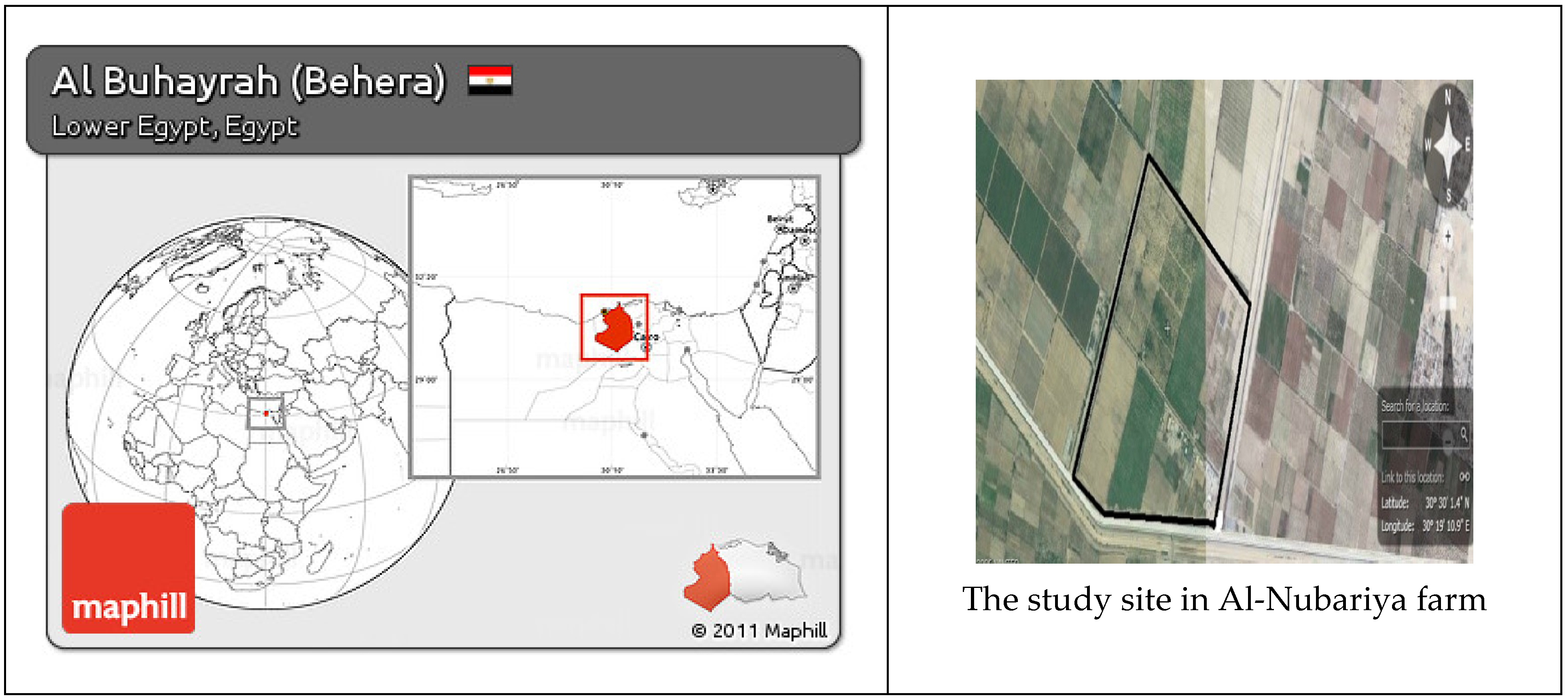



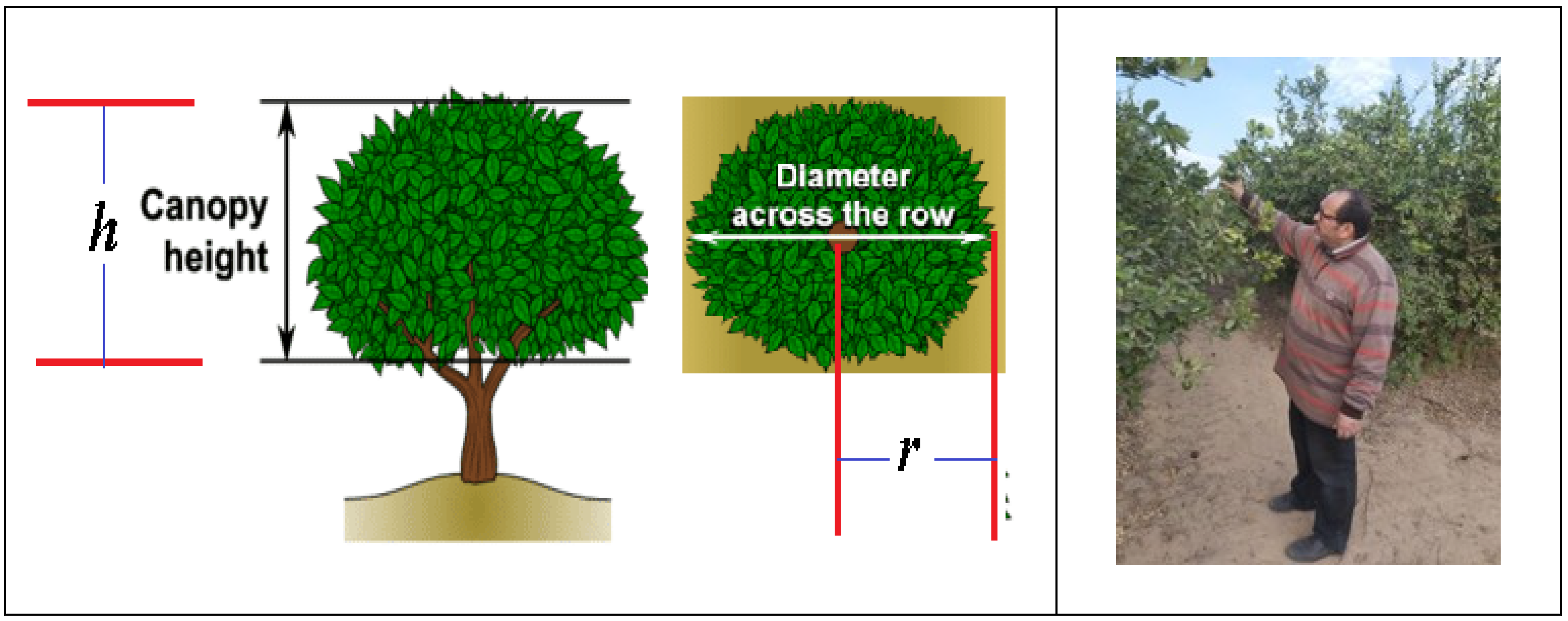
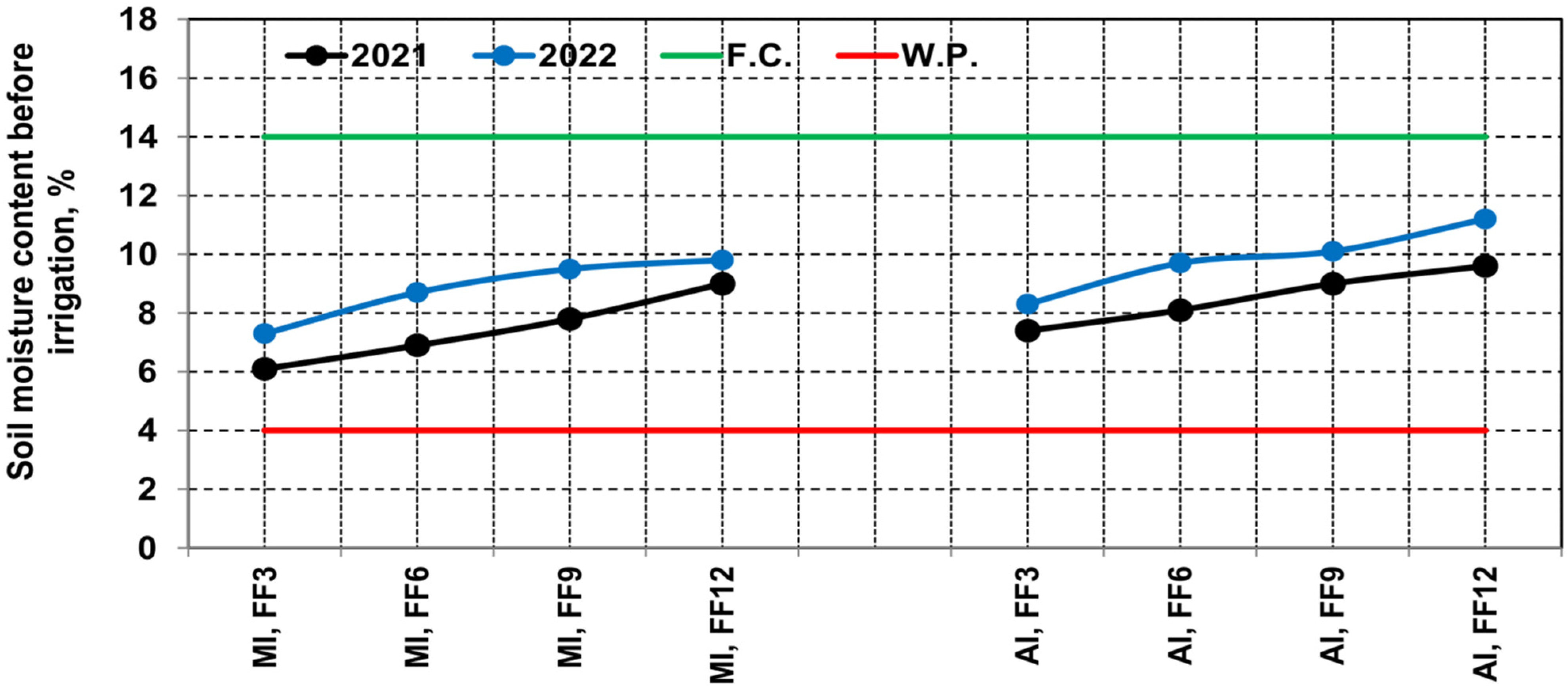
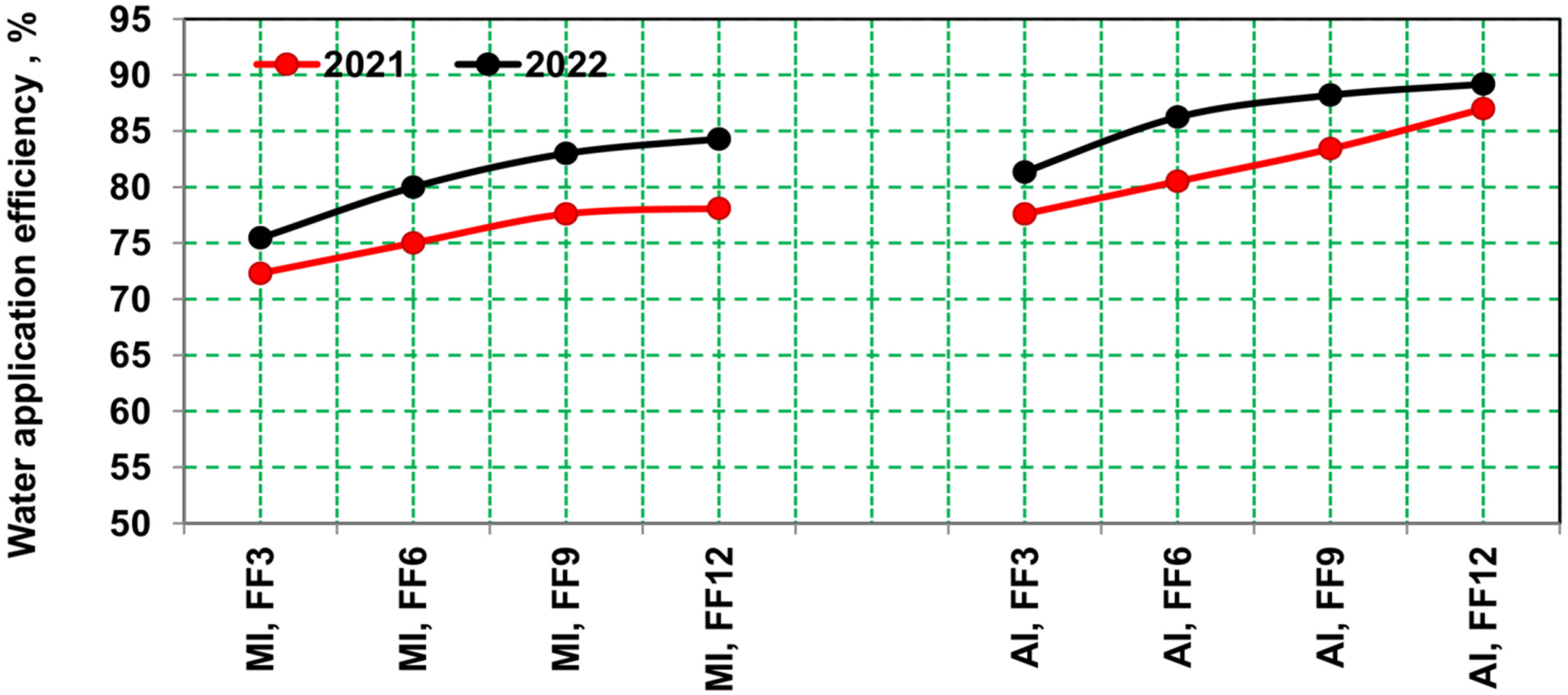



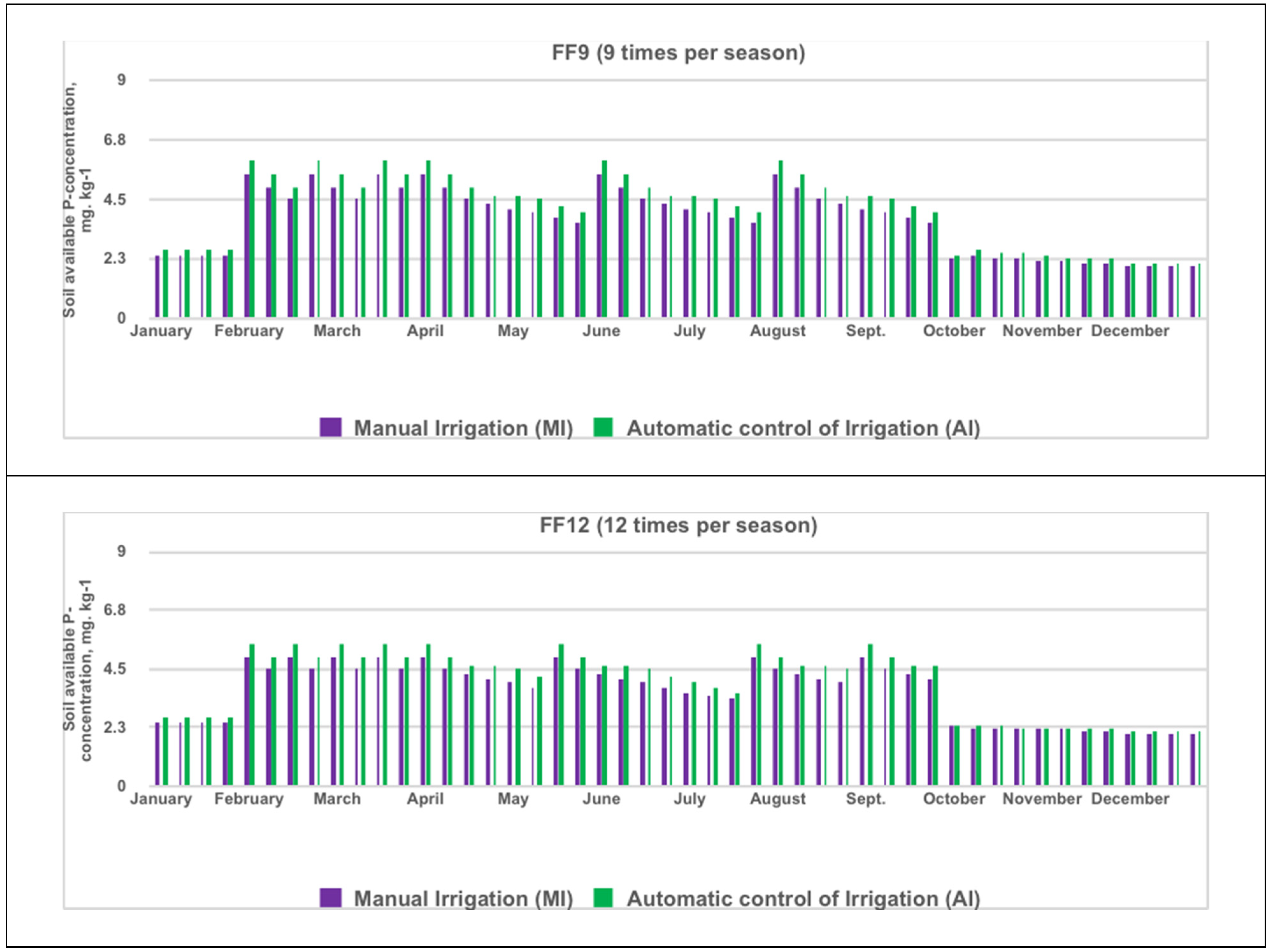
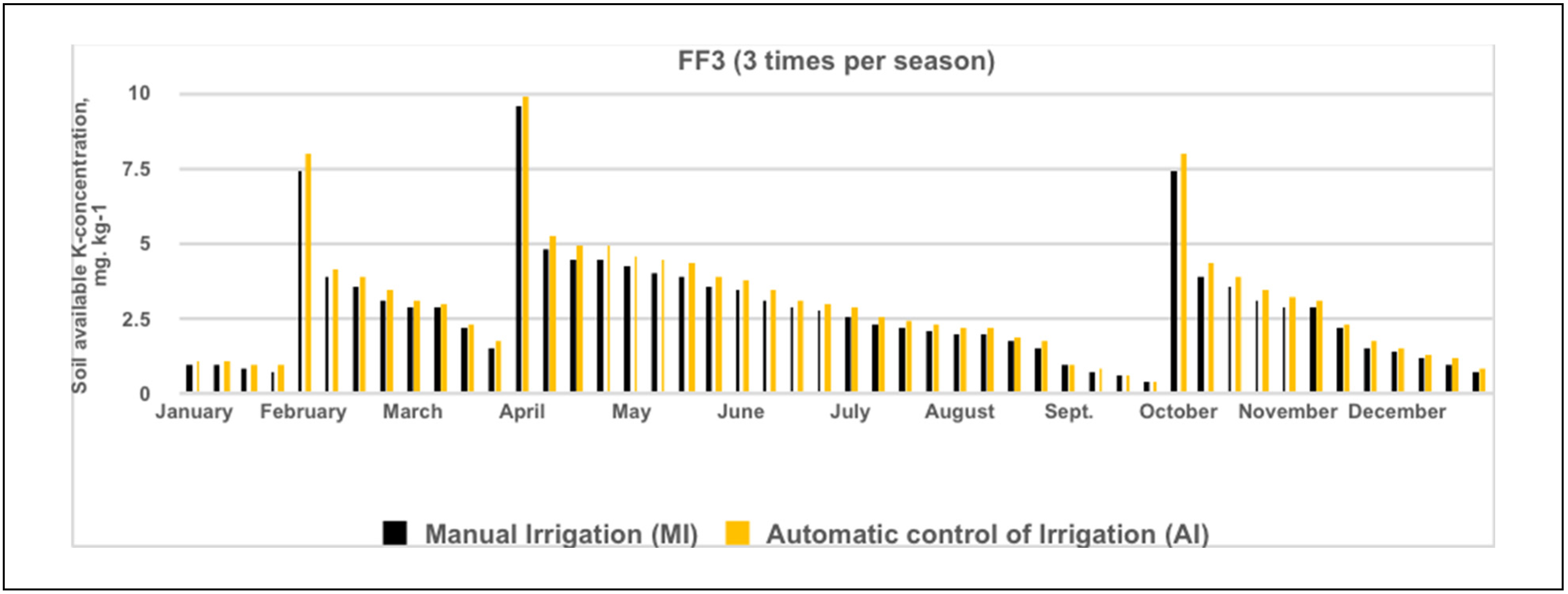
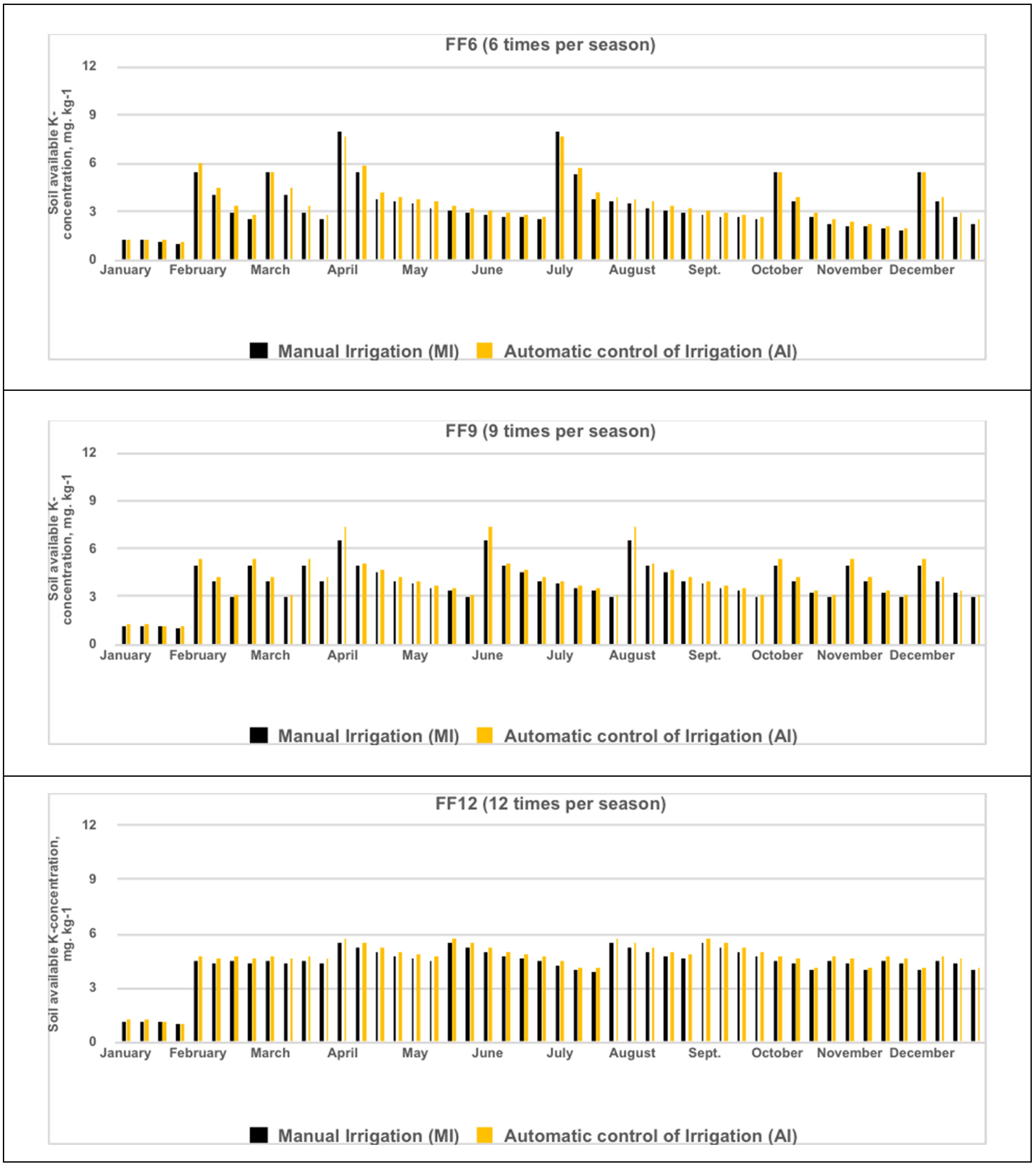
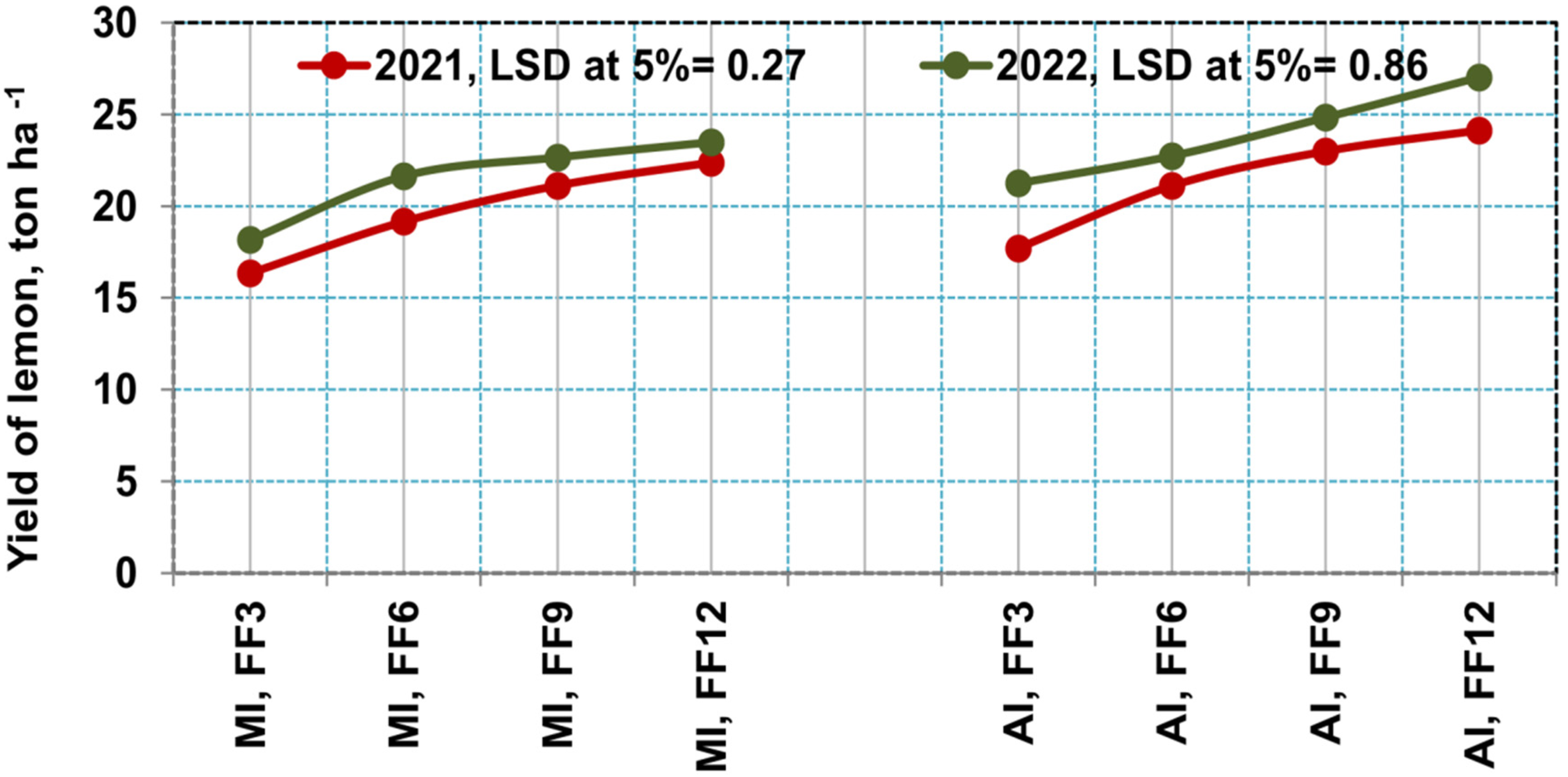
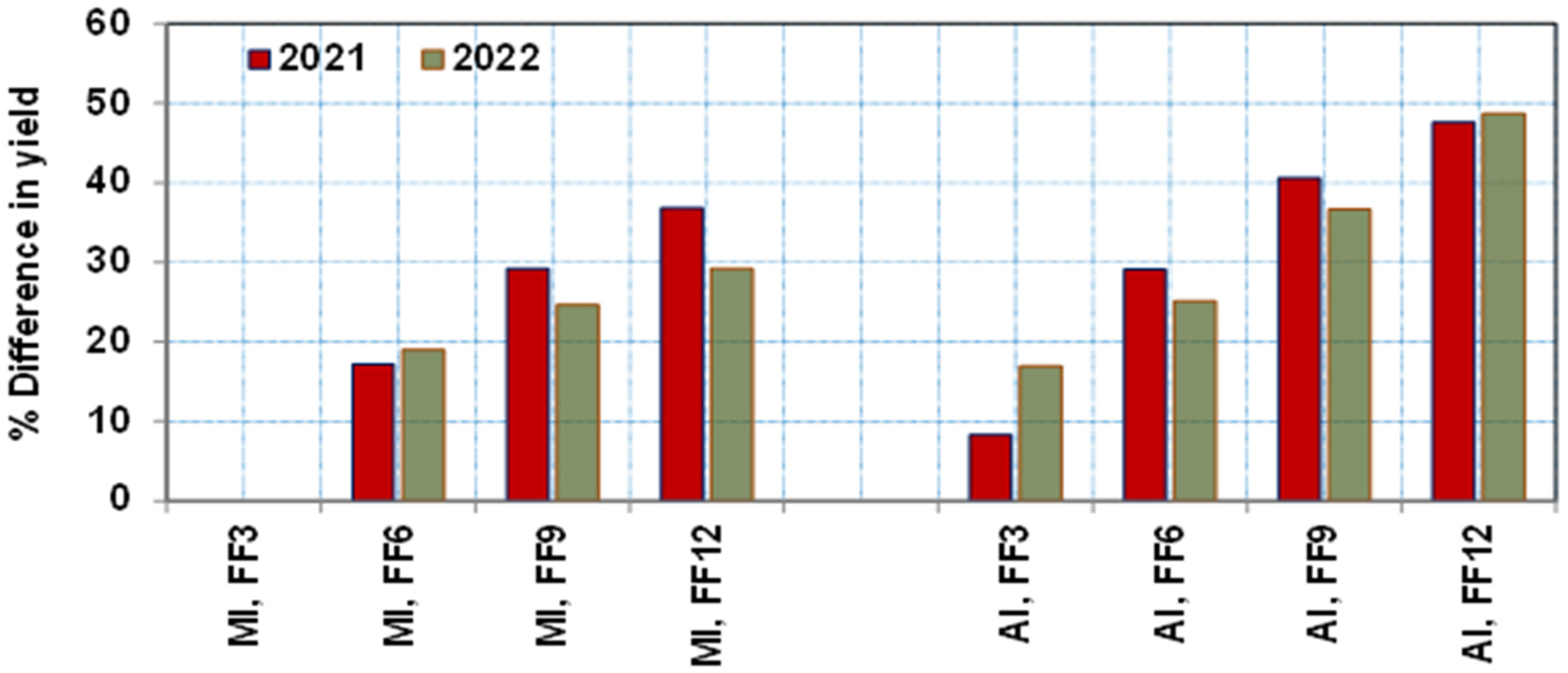
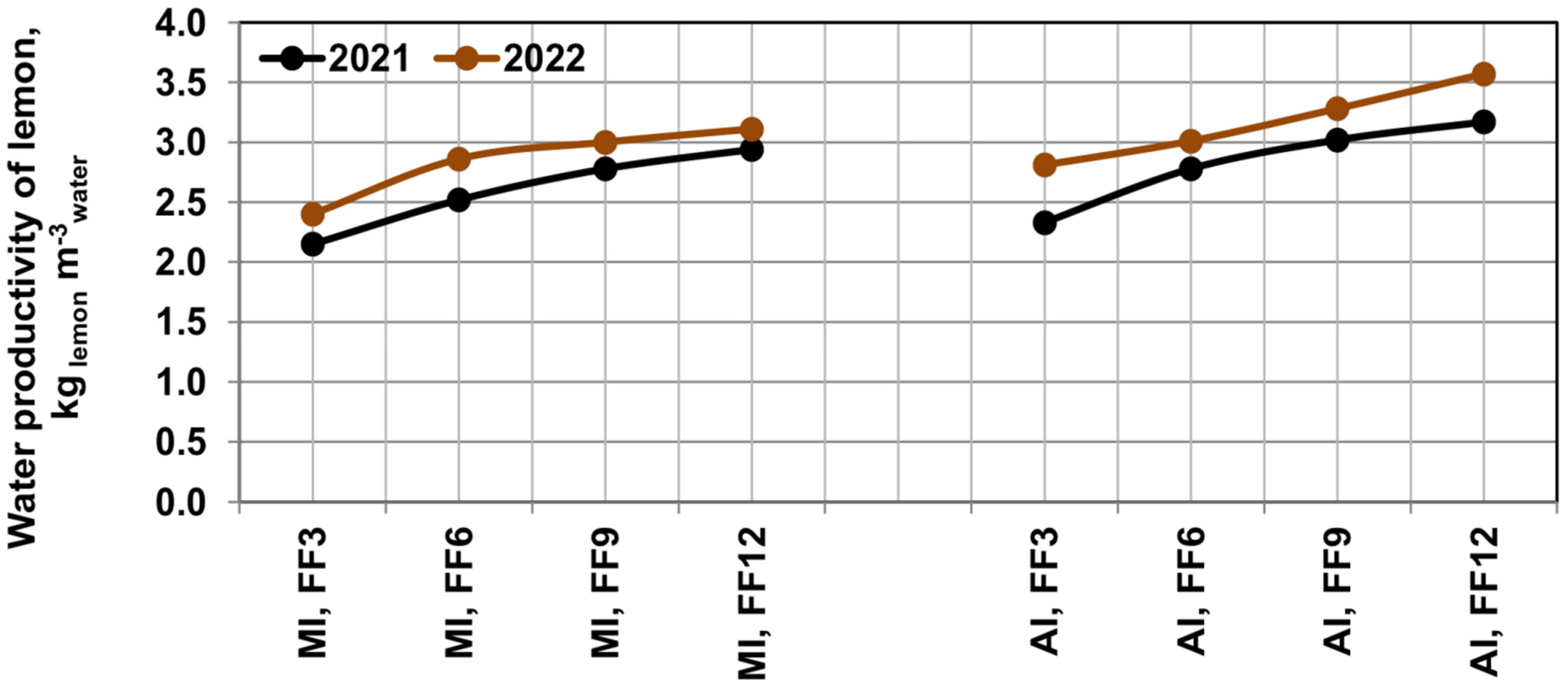
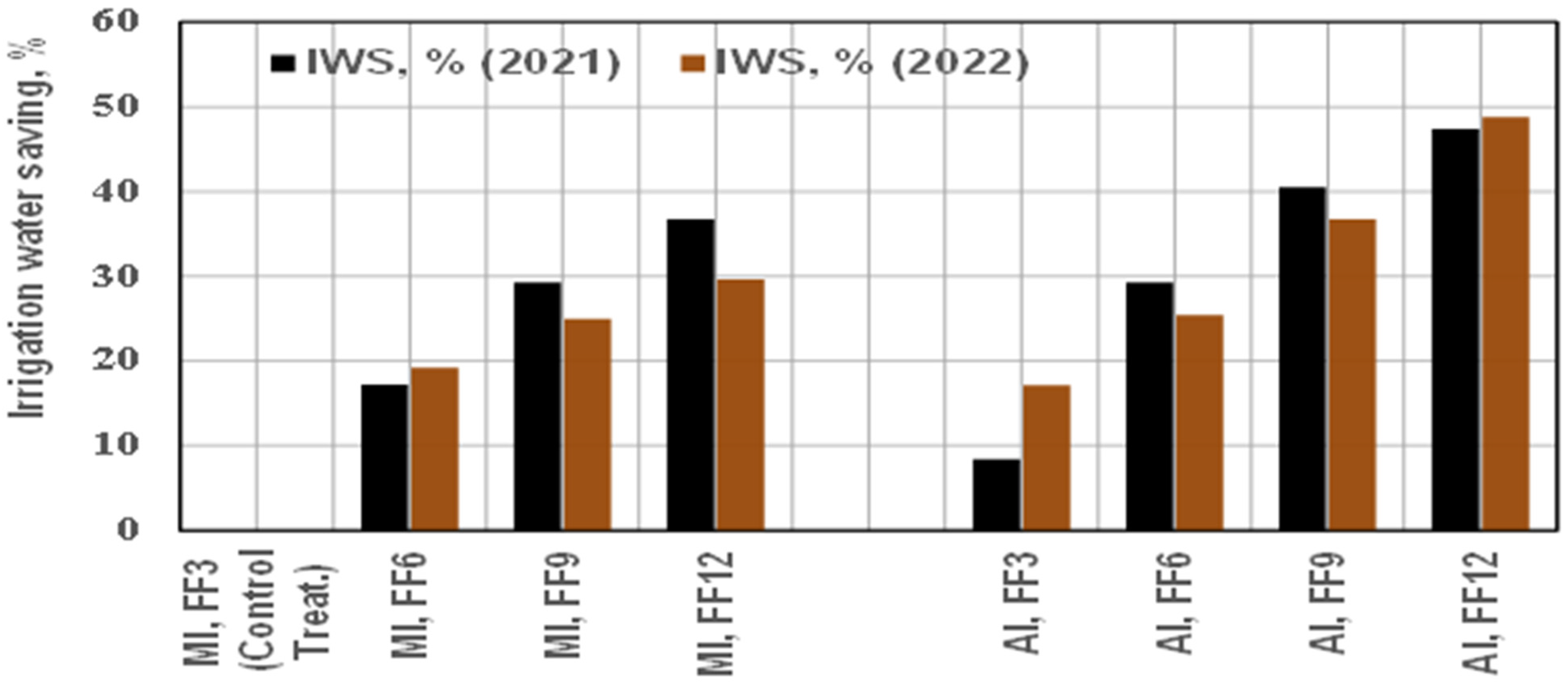
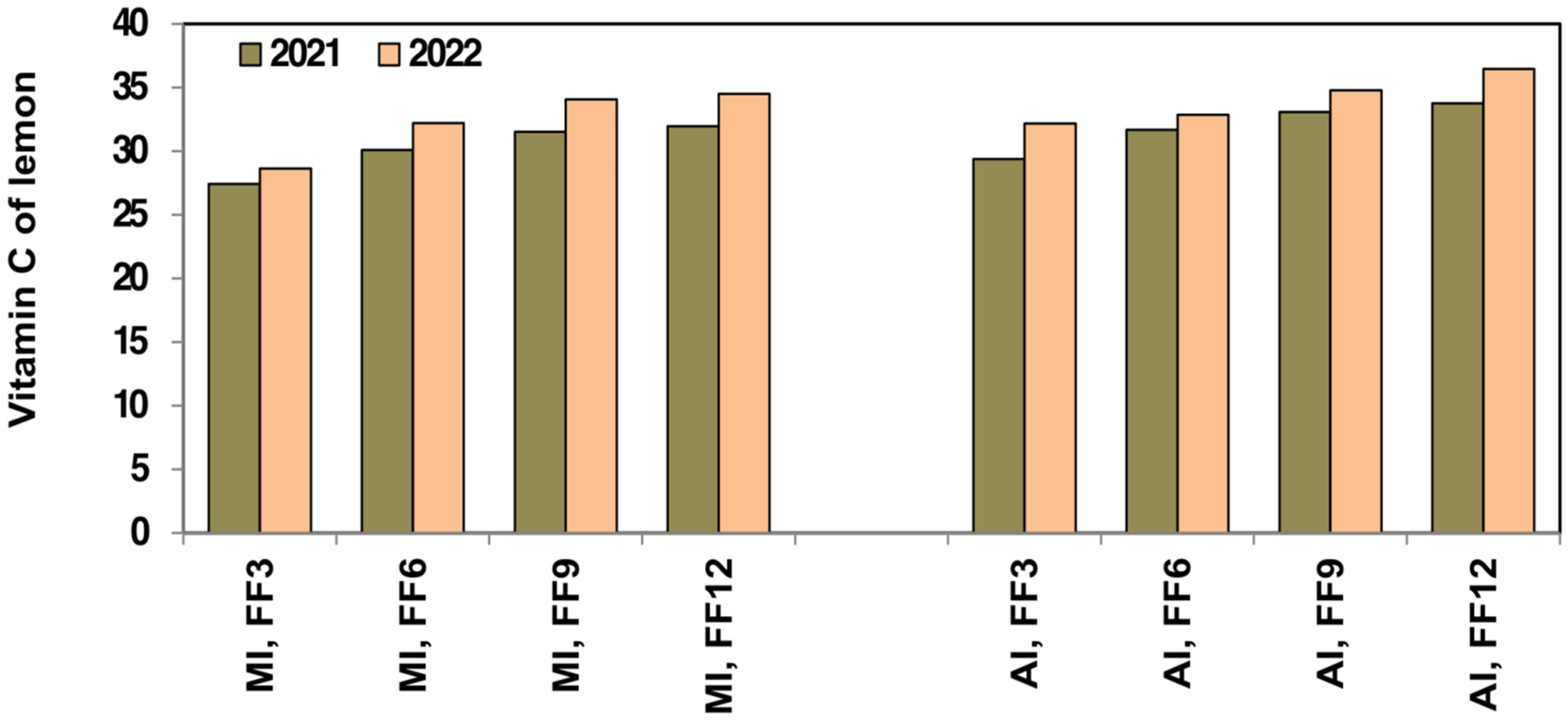
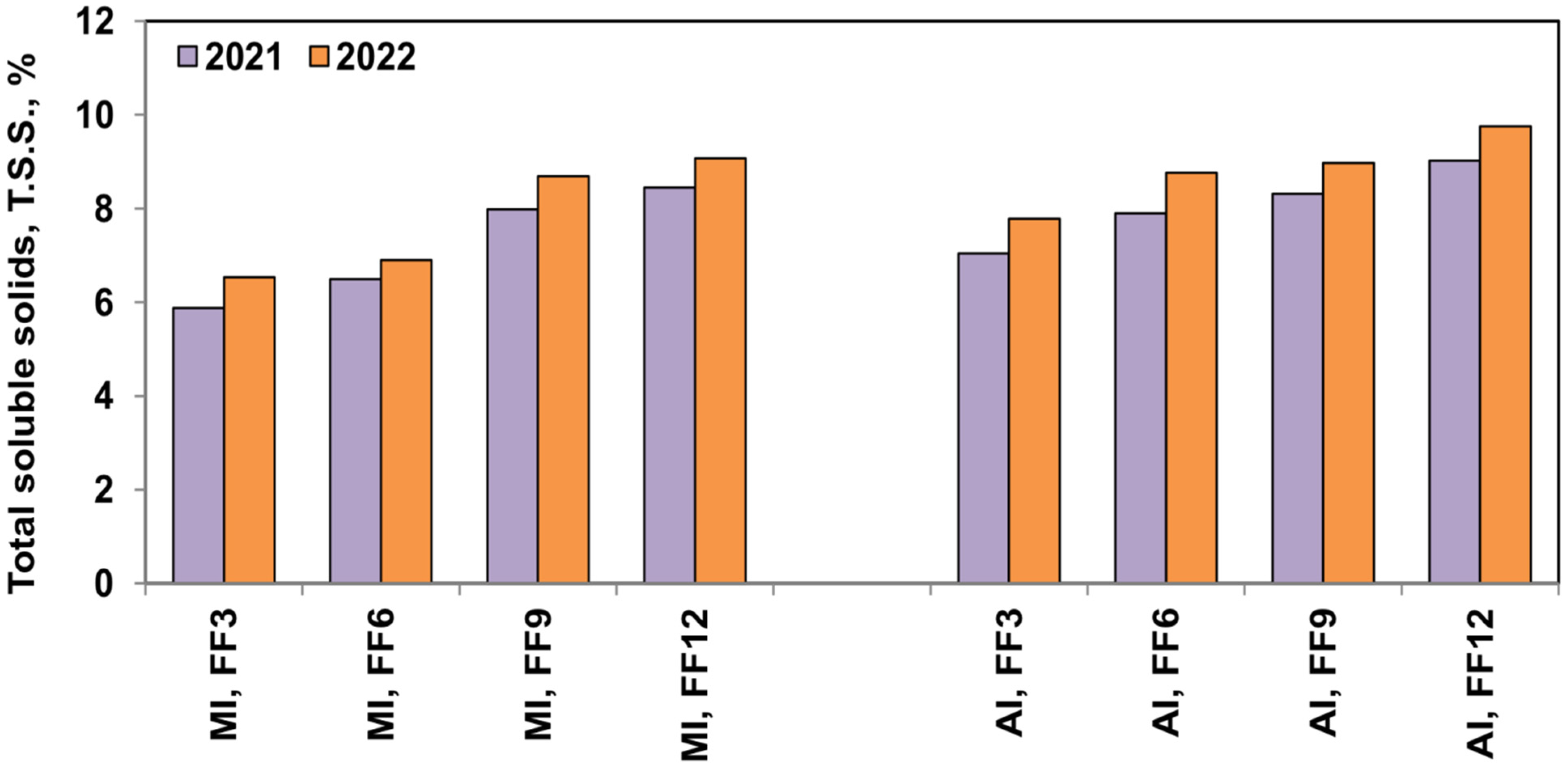
| Soil Characteristics | Soil Depth (cm) | ||
|---|---|---|---|
| 0–30 | 30–60 | 60–90 | |
| Texture | Sandy | Sandy | Sandy |
| Coarse sand (%) | 46.06 | 45.21 | 44.93 |
| Fine sand (%) | 51.43 | 49.58 | 50.47 |
| Silt + clay (%) | 2.51 | 5.21 | 4.60 |
| Bulk density (t m−3) | 1.66 | 1.65 | 1.67 |
| Organic matter (%) | 0.64 | 0.49 | 0.27 |
| EC (1:2.5) (dS m−1) | 0.58 | 0.53 | 0.55 |
| pH | 8.2 | 8.5 | 8.6 |
| Total CaCO3 (%) | 7.27 | 4.44 | 4.66 |
| Fertilization frequency | Before flowering | Beginning of fruition | The end of the natural fall of the fruits | |||||||||||||||||||||||||||||||||||||||||||||||||||
| N | P | K | N | P | K | N | P | K | ||||||||||||||||||||||||||||||||||||||||||||||
| 129.6 | 72 | 144 | 129.6 | 72 | 192 | 172.8 | 0 | 144 | ||||||||||||||||||||||||||||||||||||||||||||||
| NH4NO3 33.5% | H3PO4 75% | K2SO4 52% | NH4NO3 33.5% | H3PO4 75% | K2SO4 52% | NH4NO3 33.5% | H3PO4 75% | K2SO4 52% | ||||||||||||||||||||||||||||||||||||||||||||||
| FF3 | 387 | 96 | 277 | 387 | 96 | 369 | 516 | 0 | 277 | |||||||||||||||||||||||||||||||||||||||||||||
| FF6 | ||||||||||||||||||||||||||||||||||||||||||||||||||||||
| FF9 | ||||||||||||||||||||||||||||||||||||||||||||||||||||||
| FF12 | ||||||||||||||||||||||||||||||||||||||||||||||||||||||
| Irrigation Control | Fertilization Frequencies (FF) | Tree Canopy Volume, (m3) | |
|---|---|---|---|
| 2021 | 2022 | ||
| Manual Irrigation (MI) | 23.8 | 25.4 | |
| Automatic control of Irrigation (AI) | 27.8 | 30.2 | |
| FF3 | 23.7 | 25.4 | |
| FF6 | 24.9 | 27.2 | |
| FF9 | 26.7 | 28.9 | |
| FF12 | 28.0 | 29.9 | |
| Manual Irrigation (MI) | FF3 | 21.9 | 23.5 |
| FF6 | 23.2 | 24.1 | |
| FF9 | 24.3 | 26.7 | |
| FF12 | 25.7 | 27.4 | |
| Automatic control of Irrigation (AI) | FF3 | 25.4 | 27.3 |
| FF6 | 26.5 | 30.2 | |
| FF9 | 29.1 | 31.1 | |
| FF12 | 30.3 | 32.3 | |
| Irrigation Control | Fertilization Frequencies (FF) | Yield of Fruits, (ton ha.−1) | Water Productivity (kg lemon m−3water) | % Difference in Yield | Irrigation Water Saving, % | ||||
|---|---|---|---|---|---|---|---|---|---|
| 2021 | 2022 | 2021 | 2022 | 2021 | 2022 | 2021 | 2022 | ||
| MI | 19.7 b | 21.5 b | 2.6 | 2.8 | 20.8 | 18.2 | 20.8 | 18.5 | |
| AI | 21.5 a | 24.0 a | 2.8 | 3.2 | 31.4 | 31.9 | 31.4 | 32.0 | |
| LSD at 5% | 0.3 | 0.1 | |||||||
| FF3 | 17.0 d | 19.7 d | 2.2 | 2.6 | 4.2 | 8.5 | 4.2 | 8.6 | |
| FF6 | 20.1 c | 22.2 c | 2.7 | 2.9 | 23.2 | 22.1 | 23.3 | 22.3 | |
| FF9 | 22.1 b | 23.7 b | 2.9 | 3.1 | 34.9 | 30.7 | 34.9 | 30.9 | |
| FF12 | 23.2 a | 25.3 a | 3.1 | 3.3 | 42.2 | 39.0 | 42.1 | 39.2 | |
| LSD at 5% | 0.2 | 0.6 | |||||||
| MI | FF3 | 16.3 g | 18.2 e | 2.2 | 2.4 | 0.0 | 0.0 | 0.0 | 0.0 |
| FF6 | 19.2 e | 21.6 d | 2.5 | 2.9 | 17.2 | 19.0 | 17.2 | 19.2 | |
| FF9 | 21.1 d | 22.7 c | 2.8 | 3.00 | 29.2 | 24.7 | 29.3 | 25.0 | |
| FF12 | 22.4 c | 23.5 c | 2.9 | 3.1 | 36.8 | 29.2 | 36.7 | 29.6 | |
| AI | FF3 | 17.7 f | 21.3 d | 2.3 | 2.8 | 8.3 | 17.0 | 8.4 | 17.1 |
| FF6 | 21.1 d | 22.7 c | 2.8 | 3.0 | 29.1 | 25.1 | 29.3 | 25.4 | |
| FF9 | 23.0 b | 24.8 b | 3.0 | 3.3 | 40.6 | 36.7 | 40.5 | 36.7 | |
| FF12 | 24.1 a | 27.0 a | 3.2 | 3.6 | 47.6 | 48.7 | 47.4 | 48.8 | |
| LSD at 5% | 0.3 | 0.9 | |||||||
| Irrigation Control | Fertilization Frequencies (FF) | Fruit Diameter, (cm) | Peel Thickness, (cm) | Fruit Weight, (gm) | |||
|---|---|---|---|---|---|---|---|
| 2021 | 2022 | 2021 | 2022 | 2021 | 2022 | ||
| MI | 6.5 | 7.0 | 0.5 | 0.5 | 154.2 | 164.4 b | |
| AI | 6.53 | 7.0 | 0.5 | 0.5 | 178.3 | 189.6 a | |
| LSD at 5% | 0.02 | NS | NS | NS | NS | 1.7 | |
| FF3 | 5.5 d | 5.6 | 0.4 c | 0.5 c | 141.1 d | 154.4 d | |
| FF6 | 6.2 c | 6.7 | 0.4 b | 0.6 b | 157.9 c | 166.1 c | |
| FF9 | 7.1 b | 7.7 | 0.4 c | 0.5 c | 180.1 b | 188.7 b | |
| FF12 | 7.2 a | 8.0 | 0.5 a | 0.6 a | 186.0 a | 198.8 a | |
| LSD at 5% | 0.1 | 0.1 | 0.01 | 0.01 | 1.3 | 0.6 | |
| MI | FF3 | 5.4 e | 5.7 e | 0.4 | 0.5 d | 131.3 g | 144.8 h |
| FF6 | 6.0 d | 6.8 d | 0.4 | 0.6 b | 142.8 f | 148.7 g | |
| FF9 | 7.1 b | 7.5 c | 0.4 | 0.5 c | 169.6 d | 175.7 e | |
| FF12 | 7.3 a | 7.9 b | 0.5 | 0.6 a | 173.0 c | 188.6 c | |
| AI | FF3 | 5.5 e | 5.5 f | 0.4 | 0.5 c | 150.9 e | 164.0 f |
| FF6 | 6.4 c | 6.7 d | 0.4 | 0.5 b | 172.9 c | 183.5 d | |
| FF9 | 7.0 b | 7.8 b | 0.4 | 0.5 d | 190.5 b | 201.7 b | |
| FF12 | 7.1 b | 8.1 a | 0.5 | 0.6 b | 198.9 a | 209.0 a | |
| LSD at 5% | 0.1 | 0.2 | NS | 0.02 | 0.9 | 0.8 | |
| Irrigation Control | Fertilization Frequencies (FF) | T.S.S., (%) | V.C mg/100 mL Juice | ||
|---|---|---|---|---|---|
| 2021 | 2022 | 2021 | 2022 | ||
| MI | 7.2 b | 7.8 b | 30.3 b | 32.4 b | |
| AI | 8.1 a | 8.8 a | 32.0 a | 34.1 a | |
| LSD at 5% | 0.1 | 0.2 | 0.2 | 0.6 | |
| FF3 | 6.5 d | 7.2 b | 28.4 d | 30.4 d | |
| FF6 | 7.2 c | 7.8 b | 30.9 c | 32.5 c | |
| FF9 | 8.2 b | 8.8 a | 32.3 b | 34.4 b | |
| FF12 | 8.7 a | 9.4 a | 32.9 a | 35.5 a | |
| LSD at 5% | 0.4 | 0.7 | 0.4 | 0.4 | |
| MI | FF3 | 5.9 f | 6.5 e | 27.4 | 28.6 f |
| FF6 | 6.5 e | 6.9 de | 30.1 | 32.2 e | |
| FF9 | 8.0 bc | 8.7 bc | 31.5 | 34.1 c | |
| FF12 | 8.5 b | 9.1 ab | 32.0 | 34.5 bc | |
| AI | FF3 | 7.0 d | 7.8 cd | 29.4 | 32.2 e |
| FF6 | 7.9 c | 8.8 abc | 31.7 | 32.8 d | |
| FF9 | 8.3 bc | 9.0 ab | 33.0 | 34.8 b | |
| FF12 | 9.0 a | 9.8 a | 33.8 | 36.5 a | |
| LSD at 5% | 0.5 | 1.0 | NS | 0.6 | |
Disclaimer/Publisher’s Note: The statements, opinions and data contained in all publications are solely those of the individual author(s) and contributor(s) and not of MDPI and/or the editor(s). MDPI and/or the editor(s) disclaim responsibility for any injury to people or property resulting from any ideas, methods, instructions or products referred to in the content. |
© 2025 by the authors. Licensee MDPI, Basel, Switzerland. This article is an open access article distributed under the terms and conditions of the Creative Commons Attribution (CC BY) license (https://creativecommons.org/licenses/by/4.0/).
Share and Cite
Eid, A.R.; Amer, B.M.A.; Bakr, B.M.M.; El-Shawadfy, M.A.; Abdou, M.A.A.; Fekry, W.M.E.; Farig, M.; Metwally, K.A.; Tarabye, H.H.H. Automatic Control of Irrigation and Increased Fertilization Frequency to Improve Lemon Production Under Dry Conditions. Horticulturae 2025, 11, 573. https://doi.org/10.3390/horticulturae11060573
Eid AR, Amer BMA, Bakr BMM, El-Shawadfy MA, Abdou MAA, Fekry WME, Farig M, Metwally KA, Tarabye HHH. Automatic Control of Irrigation and Increased Fertilization Frequency to Improve Lemon Production Under Dry Conditions. Horticulturae. 2025; 11(6):573. https://doi.org/10.3390/horticulturae11060573
Chicago/Turabian StyleEid, Abdelraouf Ramadan, Baher M. A. Amer, Basem M. M. Bakr, Mohamed A. El-Shawadfy, Mamdouh A. A. Abdou, Waleed M. E. Fekry, Mohamed Farig, Khaled A. Metwally, and Hassan H. H. Tarabye. 2025. "Automatic Control of Irrigation and Increased Fertilization Frequency to Improve Lemon Production Under Dry Conditions" Horticulturae 11, no. 6: 573. https://doi.org/10.3390/horticulturae11060573
APA StyleEid, A. R., Amer, B. M. A., Bakr, B. M. M., El-Shawadfy, M. A., Abdou, M. A. A., Fekry, W. M. E., Farig, M., Metwally, K. A., & Tarabye, H. H. H. (2025). Automatic Control of Irrigation and Increased Fertilization Frequency to Improve Lemon Production Under Dry Conditions. Horticulturae, 11(6), 573. https://doi.org/10.3390/horticulturae11060573










